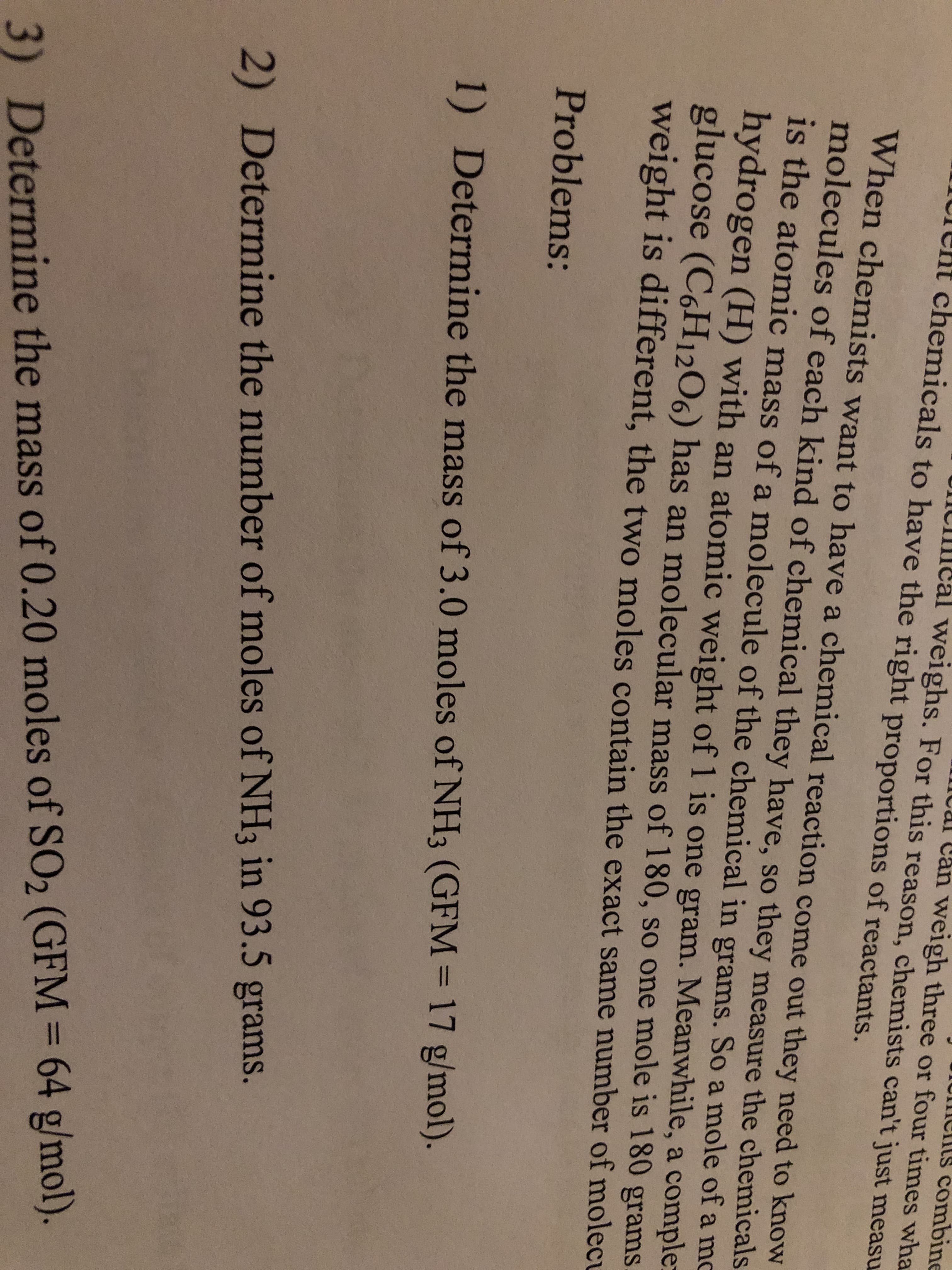S combine Can weigh three or four times wha Iical weighs. For this reason, chemists can't just measu t chemicals to have the right proportions of reactants. When chemists want to have a chemical reaction come out they need to know molecules of each kind of chemical they have, so they measure the chemicals is the atomic mass of a molecule of the chemical in grams. So a mole of a mo hydrogen (H) with an atomic weight of 1 is one gram. Meanwhile, a comple glucose (C6H1206) has an molecular mass of 180, so one mole is 180 grams weight is different, the two moles contain the exact same number of molecu Problems: 17 g/mol). 1) Determine the mass of 3.0 moles of NH3 (GFM 2) Determine the number of moles of NH3 in 93.5 grams. 3) Determine the mass of 0.20 moles of SO2 (GFM = 64 g/mol).
S combine Can weigh three or four times wha Iical weighs. For this reason, chemists can't just measu t chemicals to have the right proportions of reactants. When chemists want to have a chemical reaction come out they need to know molecules of each kind of chemical they have, so they measure the chemicals is the atomic mass of a molecule of the chemical in grams. So a mole of a mo hydrogen (H) with an atomic weight of 1 is one gram. Meanwhile, a comple glucose (C6H1206) has an molecular mass of 180, so one mole is 180 grams weight is different, the two moles contain the exact same number of molecu Problems: 17 g/mol). 1) Determine the mass of 3.0 moles of NH3 (GFM 2) Determine the number of moles of NH3 in 93.5 grams. 3) Determine the mass of 0.20 moles of SO2 (GFM = 64 g/mol).
Chemistry: Principles and Reactions
8th Edition
ISBN:9781305079373
Author:William L. Masterton, Cecile N. Hurley
Publisher:William L. Masterton, Cecile N. Hurley
Chapter3: Mass Relations In Chemistry; Stoichiometry
Section: Chapter Questions
Problem 1QAP: One chocolate chip used in making chocolate chip cookies has a mass of 0.324 g. (a) How many...
Related questions
Question
Question 1

Transcribed Image Text:S combine
Can weigh three or four times wha
Iical weighs. For this reason, chemists can't just measu
t chemicals to have the right proportions of reactants.
When chemists want to have a chemical reaction come out they need to know
molecules of each kind of chemical they have, so they measure the chemicals
is the atomic mass of a molecule of the chemical in grams. So a mole of a mo
hydrogen (H) with an atomic weight of 1 is one gram. Meanwhile, a comple
glucose (C6H1206) has an molecular mass of 180, so one mole is 180 grams
weight is different, the two moles contain the exact same number of molecu
Problems:
17 g/mol).
1) Determine the mass of 3.0 moles of NH3 (GFM
2) Determine the number of moles of NH3 in 93.5 grams.
3) Determine the mass of 0.20 moles of SO2 (GFM = 64 g/mol).
Expert Solution
This question has been solved!
Explore an expertly crafted, step-by-step solution for a thorough understanding of key concepts.
Step by step
Solved in 2 steps with 2 images

Knowledge Booster
Learn more about
Need a deep-dive on the concept behind this application? Look no further. Learn more about this topic, chemistry and related others by exploring similar questions and additional content below.Recommended textbooks for you

Chemistry: Principles and Reactions
Chemistry
ISBN:
9781305079373
Author:
William L. Masterton, Cecile N. Hurley
Publisher:
Cengage Learning

Chemistry: Matter and Change
Chemistry
ISBN:
9780078746376
Author:
Dinah Zike, Laurel Dingrando, Nicholas Hainen, Cheryl Wistrom
Publisher:
Glencoe/McGraw-Hill School Pub Co

Introductory Chemistry: A Foundation
Chemistry
ISBN:
9781337399425
Author:
Steven S. Zumdahl, Donald J. DeCoste
Publisher:
Cengage Learning

Chemistry: Principles and Reactions
Chemistry
ISBN:
9781305079373
Author:
William L. Masterton, Cecile N. Hurley
Publisher:
Cengage Learning

Chemistry: Matter and Change
Chemistry
ISBN:
9780078746376
Author:
Dinah Zike, Laurel Dingrando, Nicholas Hainen, Cheryl Wistrom
Publisher:
Glencoe/McGraw-Hill School Pub Co

Introductory Chemistry: A Foundation
Chemistry
ISBN:
9781337399425
Author:
Steven S. Zumdahl, Donald J. DeCoste
Publisher:
Cengage Learning

Introductory Chemistry: An Active Learning Approa…
Chemistry
ISBN:
9781305079250
Author:
Mark S. Cracolice, Ed Peters
Publisher:
Cengage Learning

Principles of Modern Chemistry
Chemistry
ISBN:
9781305079113
Author:
David W. Oxtoby, H. Pat Gillis, Laurie J. Butler
Publisher:
Cengage Learning

World of Chemistry, 3rd edition
Chemistry
ISBN:
9781133109655
Author:
Steven S. Zumdahl, Susan L. Zumdahl, Donald J. DeCoste
Publisher:
Brooks / Cole / Cengage Learning